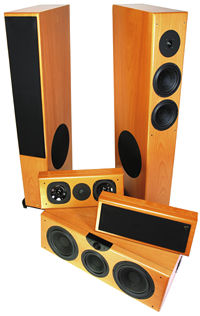Vienna Acoustics Strauss surround speaker system
Overture
Veneered in a honey beech, the Vienna Acoustics Strauss looks ready to conduct a visual symphony. VA has perfected a way of bending veneers around sharply curved edges using membrane presses. This means they can design their cabinets for optimum sonic benefit while still making stylishly shaped enclosures. With baffles of 1.5-inch-thick MDF, extensive internal bracing based on their own finite-element analysis, and a back rake that time-aligns the drivers, the Strauss impresses without looking massive or ungainly.
 The Strauss has a 3-way crossover. A 1-inch silk-dome tweeter using a unique multiple-magnet system handles the high frequencies. Its three center-drilled neodymium magnets guide internal sound waves into a special damping chamber that drastically reduces upper-frequency compression effects and the amplitude of the tweeter's natural resonant frequencies.
The Strauss has a 3-way crossover. A 1-inch silk-dome tweeter using a unique multiple-magnet system handles the high frequencies. Its three center-drilled neodymium magnets guide internal sound waves into a special damping chamber that drastically reduces upper-frequency compression effects and the amplitude of the tweeter's natural resonant frequencies.
The midrange and bass drivers are made of air-dried paper reinforced with carbon fiber to increase rigidity and internal damping. The two midrange drivers share a complementary crossover: The upper driver handles the entire midrange, while the lower one rolls off its upper-frequency output to concentrate on the lower midrange. The claimed benefits of this arrangement include superior power handling and better imaging: The upper-midrange frequencies, which supply critical imaging and locational cues, are produced by the smaller radiating area of a single driver. The lower-midrange frequencies deliver most of the dynamic energy, and they come from the combined radiating areas of two drivers, thus increasing the Strauss's power-handling capabilities.
The Strauss's woofer begins operation at around 70Hz, which is low enough to free the lower-midrange driver from having a crossover point in critically audible frequencies. According to VA's specifications, the woofer extends down to 26Hz. The woofer is on the side of the cabinet, allowing the Strauss to be set up with its woofer firing toward the room's center or outside walls. Such flexibility in placement makes it possible to achieve better room optimization.
The Oratorio center-channel speaker was designed to work with the Strauss or the larger Mahler speaker. It's a 3-way bass-reflex design with ports on the side, and its tweeter and its midrange driver are identical to those in the Strauss. But instead of having a second midrange driver and a single, side-firing 11-inch woofer, the Oratorio has two front-firing 9-inch woofers that handle frequencies of 33–120Hz. With its raked-back front baffle and aerodynamic parallelogram shape, the Oratorio looks much lighter than its 66 pounds.
Vienna Acoustics' US distributor, Sumiko, also sent along two Waltzes to use as surround speakers. Unlike the Strauss and Oratorio, the Waltz has a 2-way symmetrical configuration in a sealed enclosure. Its cabinet features an asymmetrical angled shape to ease its placement on ceiling, wall, corner, or stand. The speaker's two pairs of connectors, one near the top and one near the bottom, also increase its placement flexibility.
While the Waltz's 1-inch silk-dome tweeter is not as expensive as the one in the Strauss and Oratorio, it's still hand-coated and quite robust. Two 5.5-inch midrange/bass drivers go down to about 70Hz. Vienna Acoustics is so confident of the Waltz's ability to handle full-range signals even at high SPLs that they suggest you set your processor for Large surrounds when using Waltzes as side or rear speakers. [But we'd recommend you try both Large and Small. With a Large setting, any surround bass that the Waltz cannot reproduce will simply disappear rather than being routed to the subwoofer.—TJN]
Although the Vienna Acoustics speakers come with very attractive grillecloths, the company representatives who installed them recommended that I do all of my critical listening without them, which I did.
The REL Q401E subwoofer is not made by Vienna Acoustics, but REL is also distributed by Sumiko. A 400W RMS discrete direct-coupled MOSFET amplifier with six output devices and an audiophile-grade toroidal transformer drive a single 12-inch, long-throw driver with a 7.6kg magnet and a 4-layer, edge-wound voice coil. The Q401E is housed in a sealed cabinet with a zero-Q suspension system (so called because the cabinet's resonance, or Q, is outside the frequency range of the sub) controlled by REL's proprietary Active Bass Control (ABC) variable bass filter, which is said to let it fill large rooms without exhibiting strong peaks in its response.
As with virtually all subs, you can use the REL in the standard manner, sending it a line-level subwoofer signal. In addition, you can simultaneously use it as a low-bass extension for your three front speakers. In this case, you connect the output of the front-speaker amplifier to the proprietary high-level input on the sub. REL supplies a special cable that breaks out into three conductors terminated in bare wire, which are connected to the amp in parallel with the front speakers. Fortunately, the impedance of this input is relatively high, so it doesn't place any significant demand on the amp.
























































